Tyrannosaurus
Probably the most heard of dinosaur of all time is the huge predator Tyrannosaurus (pronounced tie-RAN-oh-SAW-us). Tyrannosaurus walked on two legs and had around 60 sharp teeth in its massive jaws. It lived between 68 and 66 million years ago, right up to the end of the Cretaceous Period and the mass extinction that changed the face of the Earth.
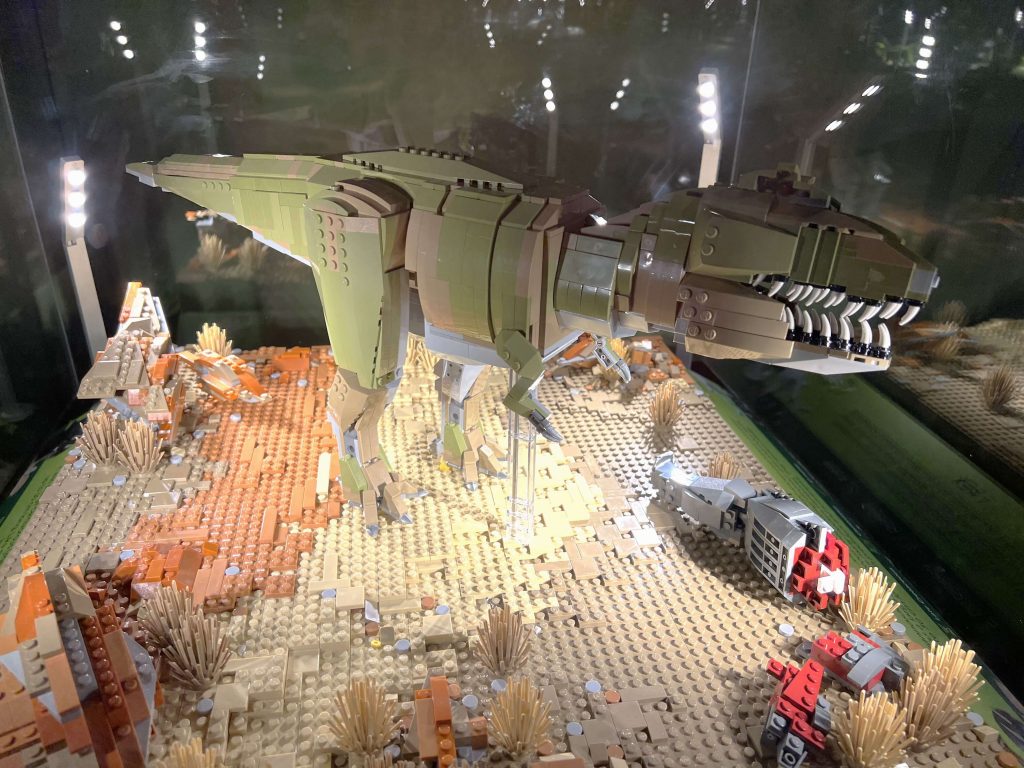
Tyrannosaurus rex in all her toothy glory.
Brick Dinos also includes specimens from the Horniman’s Natural Sciences collections. Casts of two Tyrannosaurus rex claw fossils can be found near the entrance. The smaller one is nearly 15cm long and is from the thumb of a T. rex. The larger claw is an incredible 2 cm in length and is a T. rex toe claw.
Nanotyrannus
You will also find a large dinosaur skull from the Horniman’s collection. This belongs to another Late Cretaceous carnivore, called Nanotyrannus (pronounced ‘NAN-oh-tie-RAN-us’).
Scientists believe Nanotyrannus, which means ‘tiny tyrant’, is a type of tyrannosaur, like T. rex. However, there is debate over what kind.
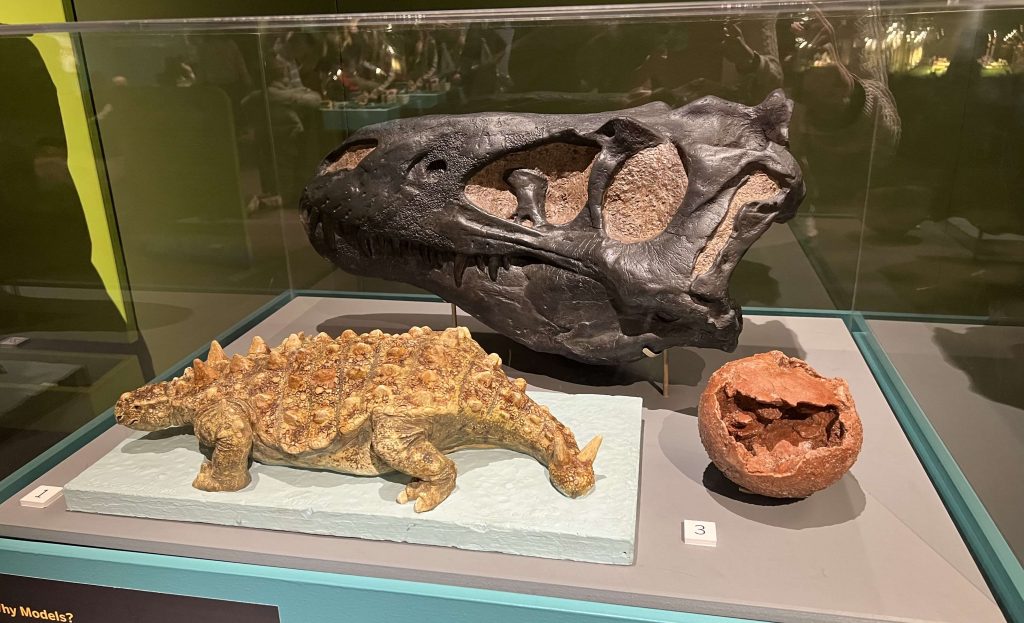
Is Nanotyrannus a unique species of small tyrannosaur, or a juvenile T. rex?
The reason it’s difficult for palaeontologists to work out is that most baby animals aren’t a scaled-down version of the adult. Imagine a human baby that’s 150cm tall! Fossilised skeletons of juvenile and adult animals of the same species can look quite different to each other. Palaeontology can be a tricky science!
Some researchers believe that due to how similar Nanotyrannus and Tyrannosaurus look, the five-metre Nanotyrannus is actually a juvenile of the 12-metre Tyrannosaurus.
Other scientists think that Nanotyrannus has sufficient physical features that are different enough from T. rex to make Nanotyrannus an entirely new species. To find out for sure, we need more evidence, and that means we need to find more fossils.
Masiakasaurus
One of the largest models in the exhibition is the menacing Masiakasaurus (pronounced ‘mah-shee-AK-kah-SAW-us’), which roars when you walk past.
Although much smaller than even Nanotyrannus, this two-metre long predator was not to be trifled with.
Its name means ‘vicious lizard’. This comes from the Malagasy word ‘masiaka’ which means vicious and ‘saurus’ which is Ancient Greek for lizard or reptile. It had sharp teeth that jutted forward, an unusual feature in dinosaurs.
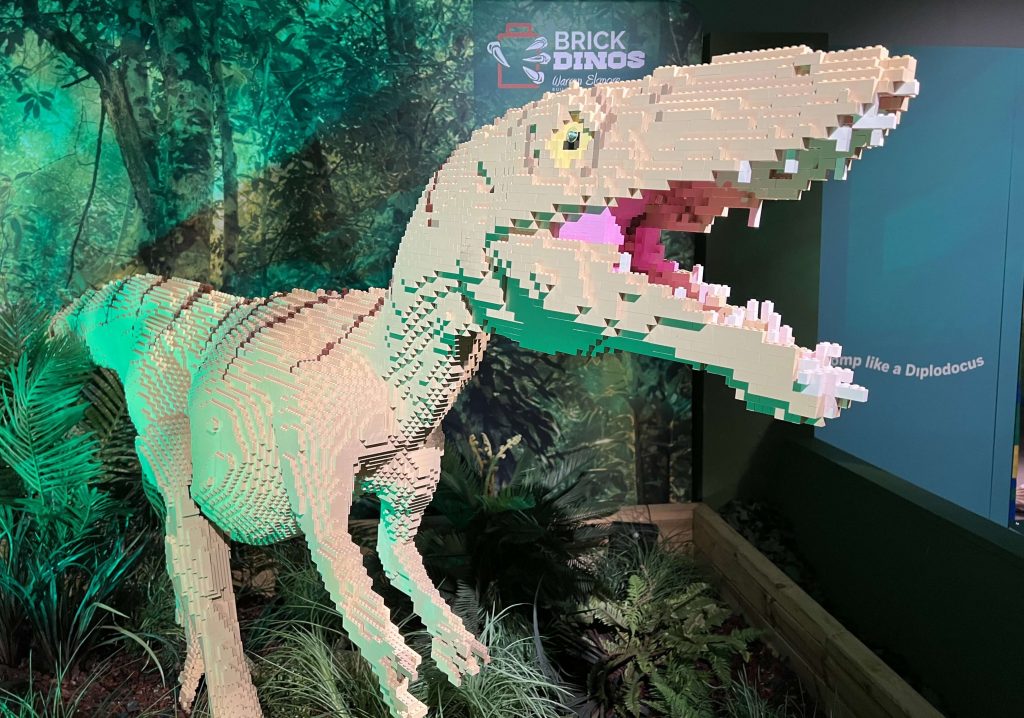
Don’t get too close to the jaws of this ‘vicious lizard’, Masiakasaurus.
Like the other dinosaurs we’ve met so far, Masiakasaurus lived in the Late Cretaceous Period. It stalked the island of Madagascar, off the southeast coast of Africa, between 84 and 71 million years ago.
Plesiosaur and ichthyosaur
Not all the Lego brick models in Brick Dinos are dinosaurs. Some other amazing prehistoric creatures have also been recreated.
A long-necked plesiosaur (pronounced PLEE-zee-oh-saw) can be seen swimming amongst Lego rocks. Plesiosaurs have no living descendants and no other species that looks anything like them. This makes it very difficult for palaeontologists to work out how they moved, hunted and reproduced.
Near the plesiosaur is a second type of swimming reptile, called an ichthyosaur (pronounced ICK-thee-oh-saw). Both plesiosaurs and ichthyosaurs are prehistoric marine reptiles. This means they lived in the sea and are part of the same group as modern reptiles like crocodiles and snakes.
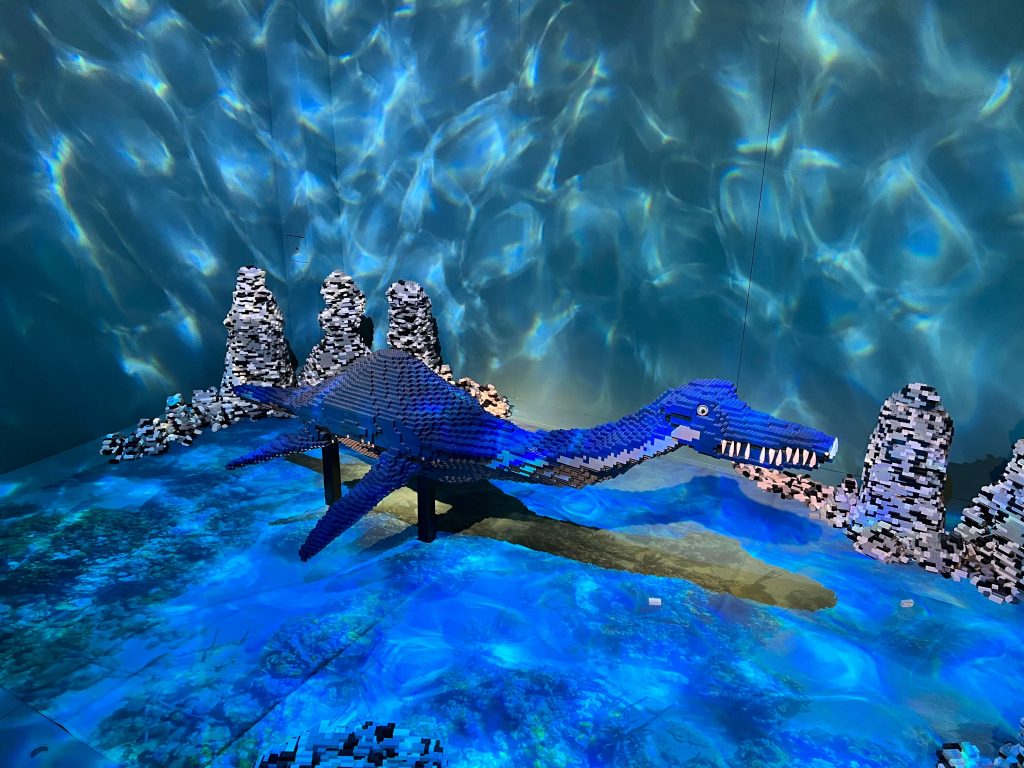
Some plesiosaurs had extremely long necks. Scientists think they probably held the neck horizontally in the water when swimming, just like this one.
Being reptiles, ichthyosaurs looked a lot more like dolphins, or the great white shark. And that’s because ichthyosaurs, dolphins and great white sharks all live in the same kind of habitat. They are active predators, and they eat similar kinds of prey. It’s because of these similarities that these different animals evolved a similar body shape. This means that ichthyosaurs looked more like dolphins, which are mammals, than any reptiles we are familiar with today.
Parasaurolophus
A pair of Parasaurolophus (pronounced pa-ra-saw-ROL-off-us) can be found grazing amongst Lego brick trees. They are identifiable by their long, thin head crests. Scientists believe that this Late Cretaceous, North American dinosaur may have been able to blow air through its crest to make a trumpeting sound.
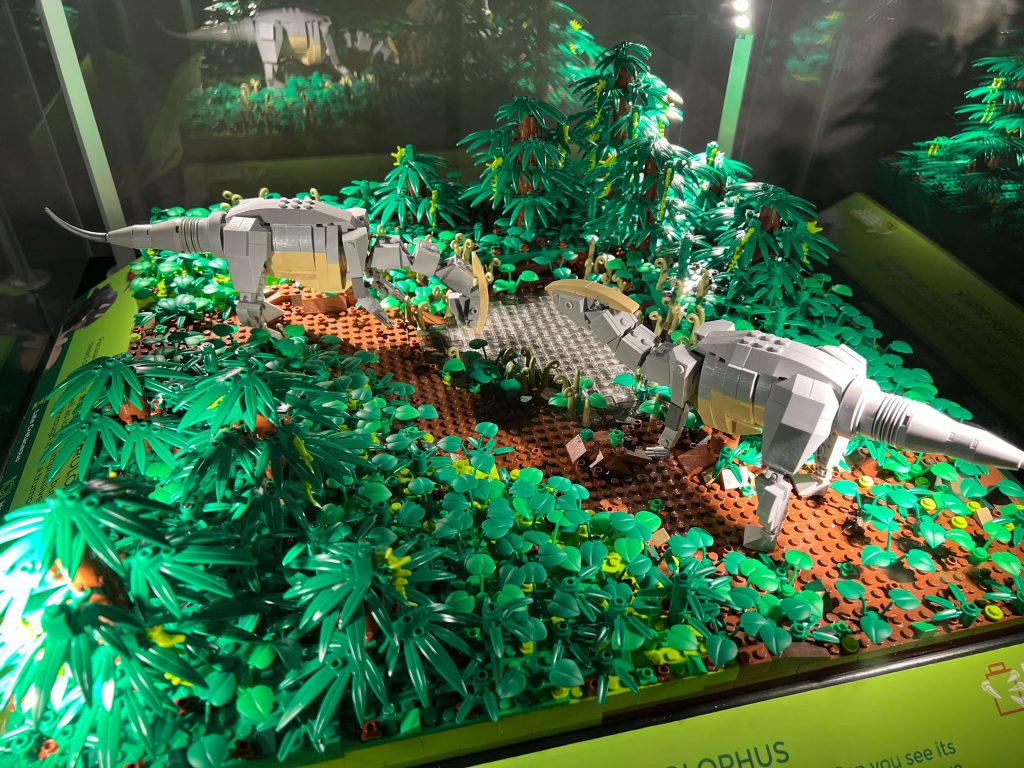
Imagine these Parasaurolophus making trumpeting sounds using their head crests.
Corythosaurus
Another crested herbivore is the bright red Lego brick dinosaur, Corythosaurus (pronounced koh-rith-OH-sore-us). The crest on this species is very different to the long thin headgear of Parasaurolophus. Its shape resembles the type of helmet that some Ancient Greeks, called Corinthians, wore. The name Corythosaurus means ‘corinthian helmet lizard’.
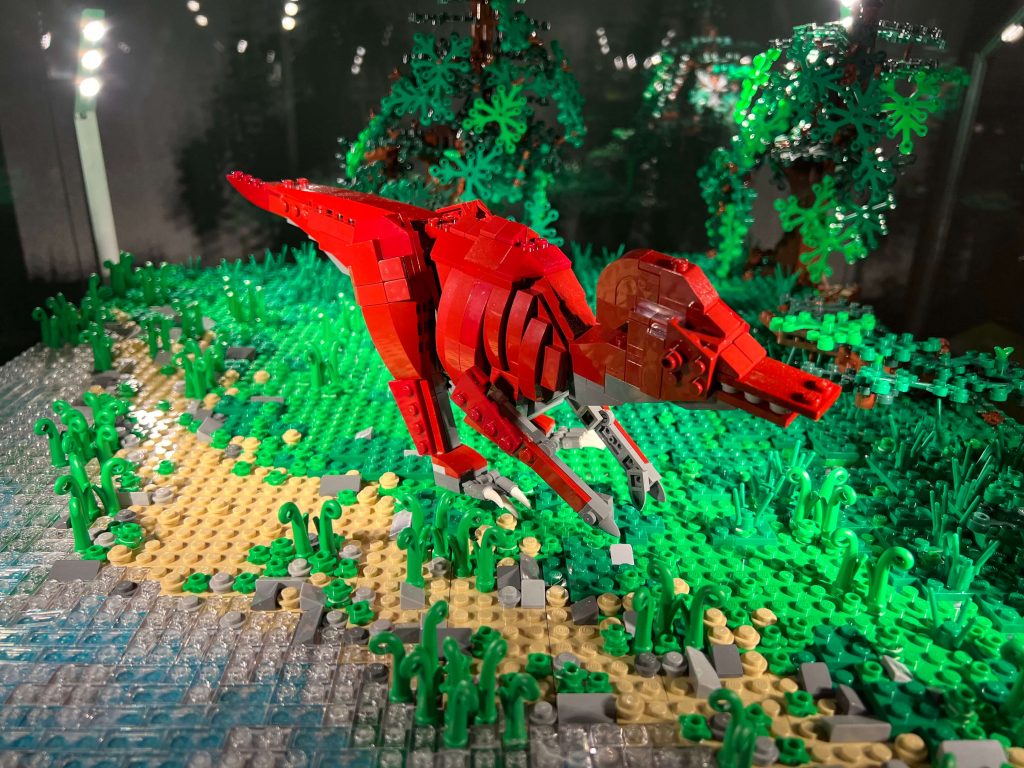
Corythosaurus had a head crest that resembled the armour of some Ancient Greek soldiers.
Iguanodon
The Horniman case with the T.rex claws also holds an incredible fossil of another herbivore. It’s a real fossil from an Iguanodon (pronounced ig-WAH-no-don) that has actual dinosaur skin preserved! This amazing fossil shows that Iguanodon had scaly skin, like most modern reptiles.
We now know that birds are also a type of dinosaur. If you look at the huge scaly feet of a large bird like the ostrich in the Natural History Gallery, it’s easy to imagine they could belong to a dinosaur from the Cretaceous Period.
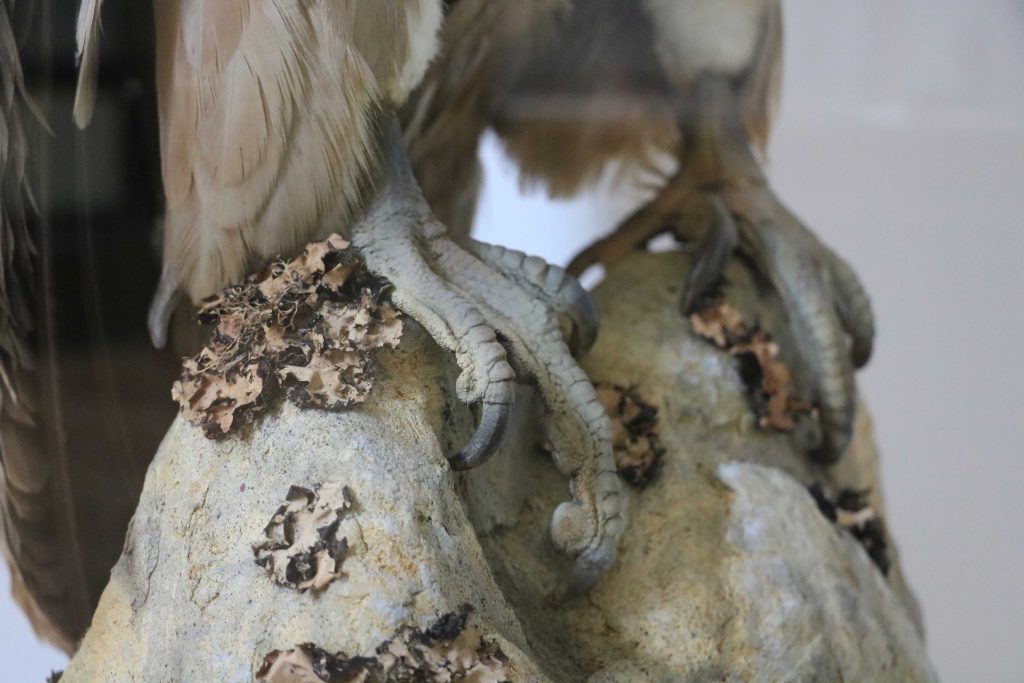
The scaly feet of a vulture in the Natural History Gallery
Sauropods
Not all of the animals in Brick Dinos are Cretaceous in age. There are a number of long-necked dinosaurs collectively called sauropods, that all date back to the Late Jurassic Period. They include Diplodocus (pronounced DIP-low-DOCK-us) with the crazily long tail, and a beautiful herd of green Brachiosaurus (pronounced BRAK-ee-oh-SAW-us) feeding on the topmost branches of the trees.
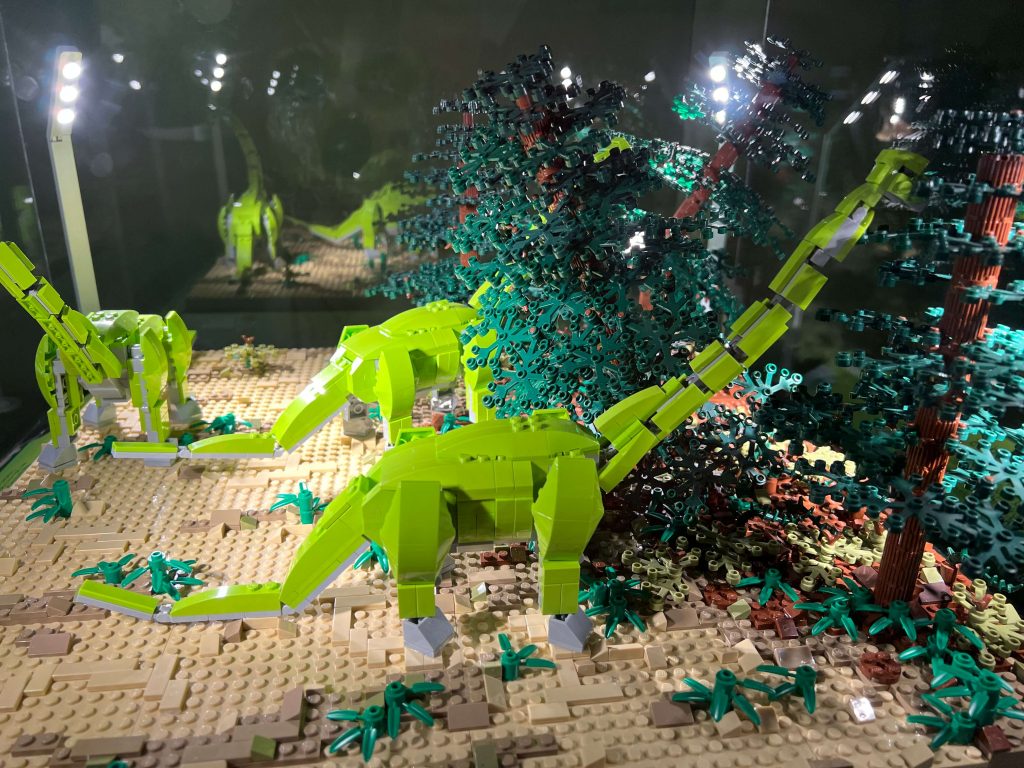
The sauropod Brachiosaurus could grow up to 30 metres from tail tip to snout, allowing it to reach very high branches from which to feed.
There are lots of other dinosaur species waiting to greet you in Brick Dinos. Discover prehistoric creatures recreated in LEGO bricks, plus fossils and other objects from the Horniman collections that are not normally on display to the public. We hope you enjoy the exhibition!


